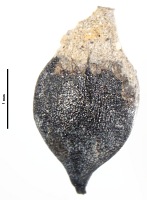
Archaeobotanical database program ArboDatMulti
The database program ArboDat, created by A.Kreuz and E. Schäffer, Wiesbaden, Archäobotanik, Wiesbaden, Germany, is based on MS Access and enables the insertion and further processing of the results of macro-remains analyses (including wood and charcoal). The uniform coding of plant taxa is fundamental to the subsequent exchange of the data. A system created by S. Jacomet (Paulsen 1995) has been used as the basis for the plant coding (PCODE).
As the ArboDat program was originally designed for use in German speaking countries, all the forms, tables and structural data were obviously written in the German language. Moreover, the whole database system had been designed according to the requirements of German users. Therefore, some changes in the structural data (e.g. the list of archaeological cultural groups or phyto-geographical units) had to be made and the appearance of some forms adapted, for the program to be used in the Czech Republic. These changes were incorporated into the structure of the multilingual version (called ArboDatMulti) designed by D. Křivánková.
The multilingual program ArboDatMulti is based on a universal program code. The universal code enables the use of ArboDatMulti in various language versions and still allows universal upgrades of the program independent of the language. Any new language version of the database can be made by simply translating and filling in all the necessary terms into the translation tables that are an inseparable part of the database. Three local versions now exist for Germany, France and the Czech Republic (and four language versions - German, French, Czech and English).
The results section of ArboDatMulti contains, among other things, the PCODE of each identified macro-remain, the type of macroremain (i.e. seed/fruit, rachis, root, wood, etc.), the state of its preservation (i.e. charred, desiccated, etc.) and the number of macro-remains of the taxon (this counting is subject to detailed rules listed in the manual of the program).
Information concerning the archaeological site and the context of analysed samples are structured hierarchically (i.e. Project-Feature-Sample). Some selected data are entered through pull-down menus, in particular data essential for further evaluation of results (i.e. archaeological dating, feature type, site type, type of sampling, type of macro-remain, preservation of macro-remain, etc.) The structure of the database also includes ecological information concerning the plant taxa involved. ArboDatMulti also contains a dozen preprogrammed queries designed for the evaluation of data according to the choice and requirements of the user.
Licence agreement
The original version of ArboDat has been created by Prof. Dr. Angela Kreuz and collaborators, Landesamt für Denkmalpflege Hessen, Wiesbaden/Germany, the copyright and the right of licensing is held by the Landesamt für Denkmalpflege Hessen, Wiesbaden/Germany.
The multilingual version of the archaeobotanical database program ArboDat is called ArboDatMulti, as to signify that it is derived from the German original version ArboDat as well as a software application on its own. ArboDatMulti is the joint product of two partner institutions: Landesamt für Denkmalpflege Hessen, Wiesbaden/Germany and Institute of Archaeology, Prague ASCR/Czech Republic.
ArboDatMulti comprises at the moment the following languages: German, English, French, Czech. The program is based on Microsoft Access and comprises one program version with translation functions as well as ArchBotData and ArchBotStrucDat with the terms added, translated for each language.
The Landesamt and The Institute are both sharing the copyright for ArboDatMulti and are both holding the right to distribute licenses for scientific archaeobotanical purposes to archaeobotanical scientists or institutions.
References
- A. Kreuz , E. Schäfer (2002): A new archaeobotanical database programme. Vegetation History and Archaeobotany 11, 177-179.
- J. Paulsen (1995): Namen und Synonyme mitteleuropäischer Gefässpflanzen. Schweizer Botanik CD 1995, Botanisches Institut der Universität Basel, Basel.

